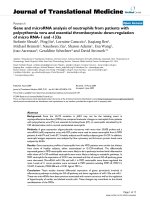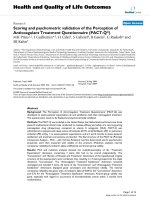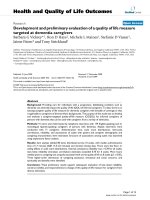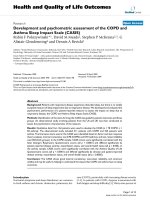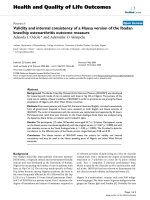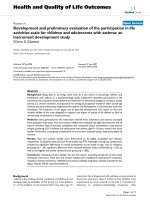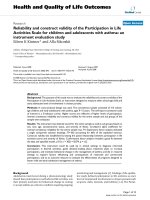Báo cáo hóa học: " Shape-tailoring and catalytic function of anisotropic gold nanostructures" doc
Bạn đang xem bản rút gọn của tài liệu. Xem và tải ngay bản đầy đủ của tài liệu tại đây (4.02 MB, 12 trang )
NANO EXPRESS Open Access
Shape-tailoring and catalytic function of
anisotropic gold nanostructures
Thathan Premkumar
1
, Kyungjae Lee
1
and Kurt E Geckeler
1,2*
Abstract
We report a facile, one-pot, shape-selective synthesis of gold nanoparticles in high yield by the reaction of an
aqueous potassium tetrachloroaurate(III) solution with a commercially available detergent. We prove that a
commercial detergent can act as a reducing as well as stabilizing agent for the synthesis of differently shaped gold
nanoparticles in an aqueous solution at an ambient condition. It is noteworthy that the gold nanoparticles with
different shapes can be prepared by simply changing the reaction conditions. It is considered that a slow
reduction of the gold ions along with shape-directed effects of the components of the detergent plays a vital
function in the formation of the gold nanostructures. Further, the as-prepared gold nanoparticles showed the
catalytic activity for the reduction reaction of 4-nitrophenol in the presence of sodium borohydride at room
temperature.
Keywords: gold, nanoparticles, detergent, catalytic activity, one-pot synthesis
Background
Nanosized metal particles are of great interest and
important for their applications in an ample diversity of
areas such as catalysis, optical devices, nanotechnology,
and biological sciences [1-4]. Among the nanoparticles
of many metals, gold (Au) nanoparticles have gained
much attention, because they have shown to be a tech-
nologically important material that can be potentially
used in application such as catalys is [5,6], chemical sen-
sors [7], in biological and medical areas [4,8], and for
the miniaturization of electronic devices due to their
unique optical and electrical properties [4,9-12]. Inter-
estingly, these characteristic properties often depend cri-
tically not only on the particle size, but also on the
particle shape [13-15]. Specially, the formation of aqu-
eous dispersible nanoparticles has concerted many
efforts in view of prospective biomedical applications
and environmental effects connected with the use of
organic solvents. Depending on the synthes is techniques
and the kind of stabilizing and reducing agents, particles
with various properties can be generat ed. While the
size-controlled synthesis of gold nanoparticles (AuNPs)
has been actively pursued, little has been done to shape
manipulations of AuNPs in an aqueous medium, which
could facilitate the various potential applications in the
fields of physics, chemistry, biology, medicine, and mate-
rials science as well as their different interdisciplinary
fields.
Though a number of preparative protocols have been
attempted and introduced to control the shape of silver
nanoparticles [16-20], analogous reports for AuNPs are
comparatively few and are more recent. These include
liquid crystal [21], templates [22], solution-based techni-
ques [23,24], and others [25] guide to the fabrication of
planar Au nanostructures with reasonable control over
their optical properties. Further, it has been reported that
AuNPs with controlled shapes were synthesized by intro-
ducing acetylacetone and several related ligands [26]. For
example, hexadecylaniline was used for the synthesis of
organically dispersi ble AuNPs, where the spontaneous
reduction of aqueous HAuCl
4
solution result s in variable
shapes of nanoparticles [27]. Recently, biosynthetic meth-
ods, an alternative to chemical synthetic procedures and
physical processes, have been introduced to the f orma-
tion of AuNPs by using plant extracts [28,29]. Also, an
excellent shape-selective formation of single crystalline
triangularAuNPsbyusingtheextractofalemongrass
plant (Cymbopogon flexuosus) was reported [30,31]. In a
* Correspondence:
1
Department of Materials Science and Engineering, Gwangju Institute of
Science and Technology (GIST), 1 Oryong-dong, Buk-gu, Gwangju 500-712,
South Korea
Full list of author information is available at the end of the article
Premkumar et al. Nanoscale Research Letters 2011, 6:547
/>© 2011 Premkumar et al; licensee Springer. This is an Open Acce ss artic le distributed under the terms of the Creative Commons
Attribution License ( which permits unre stricted use, distribution, and reproduction in
any medium, p rovided the original w ork is properly cited.
break from tradition, which has hitherto relied on the use
of either reducing agents such as NaBH
4
,N
2
H
4
,and/or
external energies such as photochemical, microwave irra-
diation, and radiolysis i n the synthesis of AuNPs in an
aqueous solution, we have recently shown that neutral
surfactants such as polysorbate 80 may be used to
synthesize spherically shaped AuNPs of different sizes in
an aqueous solution at different experimental cond itions
without utilizing any additional reducing agents and
energies [32].
In this paper, we report the facile, one-pot, shape-
selective synthesis of AuNPs in high yield by the reac-
tion of an aqueous KAuCl
4
solution with a commercially
available detergent. We demonstrate that by altering the
reaction conditions such as concentration of the reac-
tants and temperatures, the percentage of Au nanostruc-
tures can be manipulated. It is considered that a slow
reduction of the Au ions along with the shape-directed
effects of the components of the detergent plays a vital
function in the formation of the Au nanostructures. The
approach introduced here does not need any harsh and
toxic reducing agents and it requires no manipulative
skills. Further, the as-prepared AuNPs showed the cata-
lytic activity for the reduction reaction of 4-nitrophenol
in the presence of sodium borohydride. An important
aspect of nanotechnology concerns the development of
experimental processes for the synthesis of nanoparticles
of different chemical compositions, sizes, shapes, and
controlled dispersity with facile approach and low cost.
This method is facile and employs gentle reaction con-
ditions in contrast to the conventional techniques using
polymers or surfactants and harsh reductants.
Results and discussion
Gold nanoparticles were synthesized by mixing appro-
priate concentrations of solutions of AuCl
4
-and
detergent at room temperature. The resulting solution
was shaken for homogenization and kept at different
temperatures (4°C, 25°C, 45°C, and 65°C) for the reac-
tion to proceed. Different concentrations of reactants
(metal ion and detergent) were also carried out, and the
changes that occurred in the formation of nanoparticles
were studied systematica lly. Final conc entrations of the
metal ion and detergent in each sample (expressed as
the millimolar concentration of metal ion and weight
percent concentrat ion of detergent, respectively) as well
as the experimental conditions and shape distributions
of the AuNPs, are summarized in Figure 1.
Mixing an aqueous solution of 0.4 mM concentration
of Au salt and detergent (1 wt.%) at room temperature
led to the appearance of a pinkish color of the solution
after about 5 h of reaction time, demonstrating the for-
mation of AuNPs. The UV-visible (UV-vis) absorption
spectrum recorded from this solution shows the charac -
teristic surface plasmon resonance band of AuNPs [12]
centered at 546 nm (Figure 2). The kinetics of formation
of AuNPs was foll owed by UV-vis spectroscopy, and the
spectra obtained are shown in Figure 2. It is observed
that with the progress of the reaction, the absorbance
intensity at 546 nm increases constantly with time,
while the absorption peak of AuCl
4
- (initial) at about
290 nm disappeared suddenly after about 1 h of reaction
time. Additionally, the surface plasmon absorption band
undergoes a slight blue shift from 558 to 540 nm with
the increase of time. Thi s shift might be due to a
decrease in the size of AuNPs formed. This band
evolved with time, finally reaching a constant absor-
bance after 48 h and only slight increases in absorption
occurred thereafter. Both the final absorbance value and
the peak position remained constant even after storage
for several weeks. To evide ntly display the reaction
dynamics of the formation of AuNPs with time, the
Figure 1 Shape distribution of AuNPs. Schematic illustration for the formation and shape distribution of AuNPs at ambient experimental
conditions.
Premkumar et al. Nanoscale Research Letters 2011, 6:547
/>Page 2 of 12
dependence of the absorption intensity of the AuNPs at
around 546 nm with time is also shown (Figure 2,
inset). As seen from this curve, the reaction was almost
terminated after around 48 h.
It was observed that the shapes of the nanoparticles
were sensitive to the concentrations of the Au salt and
detergent. By varying the concentrations of the reac-
tants, we were able to produce nanocrystals of different
shapes. In order to study the influence of concentration
of the reactants with respect to the shape of the AuNPs,
the reactions were performed at room temperature with
0.4 mM molar concentration of Au precursor; 1, 10, and
25 wt.% concentrations of detergent; and 1 mM and 1
wt.% concentrations of Au precursor and detergent,
respectively (Table 1). Transmission electron microscopy
(TEM) image (0.4 mM Au salt and 1 wt.% detergent,
Figure 3a) showed that an almost equal percentage of
particles had both triangular (44.75%) and spherical
(42.01%) shapes. Worth to mention here is that a n
increase of the concentration of the detergent to 10 and
25 wt.%, while keeping the concentration of the Au pre-
cursor constant, led to a formation of Au nanospheres
or spher ical shape (Figure 3b,3c) AuNPs with >95% (see
Table 1). In the recent reports, the metal plate-like
structures have been obtained by using mild reaction
conditions, which play a significant role in the nuclea-
tion and growth of anisotropic particles [ 23,31,33]. In
the present case, the detergent acts in a dual role as
reducing and protectin g agent. Thus, it has to be con-
sidered that by raising the concentration of detergent,
both the reduction rate and protecting action of the
detergent solution increase. We anticipate that the high
concentration (10 and 25 wt.%) of the detergent gave
rise to an increase in the reduction rate that may influ-
ence the formation of spherically shaped AuNPs by
increasing the ra te of nucleation and growth. Thi s may
be the reason why the spherical AuNPs is favored while
increasing the concentration of the detergent.
In one particular experiment, the Au precursor con-
centration was increased to 1 from 0.4 mM, which was
Figure 2 UV-visible absorption spectra. UV-visible absorption spectra during the reaction at room temperature of a sample prepared with 0.4
mM Au salt and 1 wt.% detergent. The inset shows the corresponding plasmon band intensity around 546 nm as a function of time.
Premkumar et al. Nanoscale Research Letters 2011, 6:547
/>Page 3 of 12
used for the synthesis of triangle and spherical nanopar-
ticles, and the final concentration b etween the Au pre-
cursor and detergent was maintained at 1 mM and 1 wt.
%, respectively. Interestingly, the observation by TEM
showed (Figure 3d) that approxi mately 47% of the parti-
cles had a projected hexagonal shape and a size range of
20 ± 5 nm. In addition to the hexagonal shapes, which
formedthemajorityoftheproduct,asmallportion
Table 1 Major shape distribution of AuNPs at different experimental conditions
Concentration of gold salt (mM)/detergent (wt.%) Temperature (°C) Shape distribution (%)
Triangular Spherical Pentagonal Hexagonal
0.4/1 25 44.8 42.0 6.4 5.5
0.4/10 25 1.3 97.4 0.7 0.7
0.4/25 25 0.6 95.3 1.4 2.7
1/1 25 18.1 14.3 46.6 19.6
0.4/1 4 76.8 7.1 5.4 10.7
0.4/1 45 25.8 57.9 14.7 1.6
0.4/1 65 6.1 69.3 6.8 2.7
Figure 3 TEM micrographs of AuNPs produced at different concentrations. TEM micrographs of AuNPs obtained at room temperature with
different concentrations of Au salt and detergent. (a) 0.4 mM, 1 wt.%, (b) 0.4 mM, 10 wt%, (c) 0.4 mM, 25 wt%, and (d) 1 mM, 1 wt%.
Premkumar et al. Nanoscale Research Letters 2011, 6:547
/>Page 4 of 12
(approximatel y 18%) of pentagonal (sizes of 19 ± 5 nm),
triangular, and spherical (each approximately 14%) parti-
cles were also commonly observed in the final produ cts
(Table 1).
It is pertinent to mention that further shape control
was noticed by simply varying the temperature of the
reaction conditions, while keeping the co ncentration of
the Au precursor and the detergent constant (0.4 mM
and 1 wt.%). With the aim to analyze the effect of tem-
perature on the shape of the AuNPs, four different tem-
peratures (4°C, 25°C, 45°C, and 65°C) were selected, and
the shape distribution of the AuNPs was confirmed
from TEM measurements. Figure 4a,b,c,d shows the
TEM micrographs of the reaction products
corresponding to temperatu res of 4°C, 25°C, 45°C, and
65°C, respectively. As can be perceived, the variation of
temperature has a significant effect on the shape of the
nanoparticles obtained.
The TEM analysis clearly reveals the format ion of tri-
angular, spherical, and a smaller number of hexagonal
and pentagonal nanoparticles. The careful analysis
shows that at 4°C almost approximately 80% of the total
nanoparticle population was owing to triangular or trun-
cated triangular AuNPs (average size or edge length,
approximately 80 nm). This is considerably higher than
values reported previously [30]. As the temperature of
the reaction condition w as increased from 4°C to 25°C,
the percentage distribution of the triangularly shaped
Figure 4 TEM micrograp hs of AuNPs obtained at different temperatures. TEM micrographs of a sample obtained with a concentration of
0.4 mM Au salt and 1 wt.% detergent at different temperatures: (a) 4°C, (b) 25°C, (c) 45°C, and (d) 65°C. The inset in (d) shows the representative
image of Au nanocubes.
Premkumar et al. Nanoscale Research Letters 2011, 6:547
/>Page 5 of 12
particles decreased (44.75%) and the formation of
spher ically shaped (42%) nanoparticles increased (Figure
4b). The same tendency was observed with a further
increase in temperature to 45°C (triangular shape, 26%;
spherical shape, 58%) and 65°C (triangular shape, 6%;
spherical shape, 70%). It is interesting to mention here
that pentagonally (approximately 15%, Figure 4c) and
cubicly shaped (approximately 15%, Figure 4d and inset)
AuNPswerealsoobservedat45°Cand65°C,respec-
tively, in additio n to the aforesaid triangularly and
spherically shaped nanoparticles. From the results
obs erved, we conclude that the percentage formation of
triangularly shaped AuNPs increased with decreasing
the reaction temperature, while the percentage forma-
tion of spherically shaped particl es increased with
increasing the reaction temperature (Table 1), which
can be explained by the higher reactivity of the deter-
gent at a higher temperature. It has been recently
reported [23,31] that slow reaction conditions play a
vital role in the growth of metal plate-like structures or
anisotropic particles of crystalline nature, which have
been evidently observed in our studies. These results
clearly show that by varying the reaction temperature
and using the same concentration ratio of AuCl
4
-to
detergent, the shape of AuNPs can be readily tuned.
Interestingly, as the temperature increased, the reaction
time for the formation of AuNPs decreased. The corre-
lation between the reaction temperature or concentra-
tion and the particle shape distribution is shown in
Figure 5. It markedly shows that the formations of trian-
gularly shaped particles are inversely proportional to the
temperature (Figure 5a) or concentration (Figure 5b),
whereas the spherically shaped particles are directly
proportional. The TEM images reveal that the as-pre-
pared particles show a minimal polydispersity and are
both well dispersed in the reaction medium and non-
agglomerated.
ItwasfoundthatAuNPsofdifferentshapesclearly
dis played different surface plasmon resonance [34]. It is
well known that the triangular nanoparticles of Au exhi-
bit two characteristic absorption bands referred to as
the transverse (out-of-plane) absorbance, approximately
concurring with the surface plasmon resonance of
spherically shaped AuNPs, and the longi tudinal (in-
plane) surface plasmon resonance band, which is due to
the strong edge length of the triangles [31]. The absor-
bance bands observed at 538 and 996 nm in the UV-vis-
near-infrared (NIR) spectrum (Figure 6) are thus clearly
due to the out-of-plane and in-plane surface plasmon
resonance bands of the nanotriangles being formed at
the reaction conditions at 4°C. Sharp peaks located at
526 nm were observed for the AuNPs synthesized at 45°
C and 65°C, implying the formation of nanospherical
shaped particles [32]. The UV-vis-NIR spectrum of the
AuNPs obtained at 25°C resembles that of spherical
nanoparticles (536 nm). The additional broader shoulder
observed at 684 nm is most likely to arise from co-exist-
ing triangular AuNPs. The spectral features of the nano-
triangles and spherical nanoparticles are fairly consistent
withtheTEMresultsaswellaspreviousreports
[30,31,35,36].
Figure 7a shows an atomic force microscopy (AFM)
image of individual or single Au nanotri angles synthe-
sized by using the reaction of 0.4 mM Au precursor and
1 wt.% detergent at 4°C temperature. The topographic
height analysis (Figure 7b) of a single Au nanotriangle
Figure 5 Shape distribution of triangular and spherical AuNPs. Graph showing the temperature (a) and detergent concentration ( b) effects
relative to the shape distribution of triangular and spherical AuNPs.
Premkumar et al. Nanoscale Research Letters 2011, 6:547
/>Page 6 of 12
and the surface profile plot (Figure 7c) show that the
particle has a thickness of 11 nm and an edge length of
approximately 140 nm.
Even though mechanisms for the formation of metal
plate-like structures or anisotropic particles have been
proposed according to the nature of the reaction condi-
tions, it still remains a subjec t of controversy. However,
it is generally accepted that the shape of an fcc nano-
cry stal is most ly decided by the ratio of the growth rate
along the [100] versus the [111] direction [ 35]. It has
been reported that the triangular and hexagonal nano-
particles bound by the stable [111] planes and the per-
fect cube bounded b y less stable [100] planes [35].
Further, some authors proposed that the formation of
the thin plate-like structures is due to the preferential
adsorption of protecting agents such as some specific
surfactants or polymers onto favored crystalline p lanes.
It is obvious that the detergent, which contains complex
functional compounds and (amine oxide, hydroxyl, and
carboxylic) groups, plays the key role in the present case
for the formation of differently shaped nanoparticles at
ambient condition. We believe that the amine oxide and
hydroxyl functional groups present in the detergent may
facilitate the reduction process and the carboxylic
groups may have an interaction with the surface of the
AuNPs and in turn stabilize the AuNPs. The chances of
influencing the shapes of AuNPs by other foreign mate-
rials are ruled out, since the detergent acts as both redu-
cing and protecting agent and no additional agents or
materials are added in the present system. Hence, we
believe that the specific interaction between the deter-
gent and the different surface planes of the AuNPs at
ambient conditions could significantly increase the
growth rate along the [100] direction and, in t urn,
reduce the growth rate along [111] plane, thus, favoring
the formation of nanoparticles of triangular and hexago-
nal shape [33].
Interestingly, occasionally we found in the T EM
images that the nanoparticles of all the shapes self-
assembledinsuchawaythattheylooklike“ nano-
flowers” (Figure 8a) or “satellite-like structures” (Figure
8b,c). The TEM images of the system in the assembled
Figure 6 UV-vis-NIR absorption spectra of AuNPs. UV-vis-NIR absorption spectra of AuNPs observed during the reaction of Au salt (0.4 mM)
with detergent (1 wt.%) at different temperature. The inset shows the photographs of the different nanoparticle solutions with color changes
during the formation of AuNPs as a function of temperature.
Premkumar et al. Nanoscale Research Letters 2011, 6:547
/>Page 7 of 12
state indeed show extended aggregates of two different-
sized particles with a (big particle and small particle)
periodicity. The nanoflower (Figure 8a) consists of single
approximately 27-nm particle surrounded by six
approximately 30- to 47-nm (of triangular or truncated
triangular shape) particles, whereas the satellite struc-
tures (spherically and hexagonally shaped nanoparticles)
compriseabigparticleboundedbymanysmall
particles, as evidenced from the TEM images (Figure 8b,
c). These self-assembled structures are significant, as
these structures form the basis for a new type o f build-
ing block that could be incorporated into multicompo-
nent nanostructured materials [37,38].
In order to investigate the catalytic activity of the as-
prepared AuNPs at room temperature, we have carried
out the reduction reaction of 4-nitrophenol by NaBH
4
Figure 7 AFM image of a single Au nanotriangle particle. (a) Representative contact mode AFM image of a single Au nanotriangle particle
obtained with the reaction of 0.4 mM Au salt and 1 wt.% detergent at 4°C temperature. (b) 3-D AFM micrograph of a single nanotriangle, and
(c) topographic height analysis of Au nanotriangle.
Figure 8 Nanoflower and satellite-like structures of AuNPs. (a) “Nanoflower” and (b, c) “satellite structures” of AuNPs.
Premkumar et al. Nanoscale Research Letters 2011, 6:547
/>Page 8 of 12
in the presence o f as-prepared AuNPs. The change
occurring in the solution was monitored visually as well
as by UV-vis spectroscopy. It is evident that a typical
absorption band of 4-nitrophenol (Figure 9a) undergoes
a bathochromic shift from 316 to 400 nm, owing to the
formation of t he 4-nitrophenolate ion, after adding an
aqueous solution of NaBH
4
. It is worth to mention here
that the addition of AuNPs prepared at 4°C to the reac-
tion medium showed a constant decrement of the 400-
nm peak intensity (Figure 9b). Finally, it disappeared
within 18 min with the concomitant appearance of new
peaks at 298 and 231 nm (in addition to characteristic
surface plasmon band of AuNPs in the 530-nm region;
see Figure 9, inset), revealing the generation of 4-amino-
phenol. It was also observed visually that the light yel-
low color of the 4-nitrophenol turned to yellowish green
rapidly after adding the aqueous solution of NaBH
4
(for-
mation of 4-nitrophenolate ion), which finally turned to
almost colorless after 18 min upon addition of the as-
prep ared AuNPs, corroborating the formation of 4-ami-
nophenol. It is pertinent to state that in the absence of
the AuNPs, the peak due to the 4-nitrophenolate ion
remained unaltered for a long time, showing the incap-
ability of NaBH
4
to reduce the 4-nitrophenolate ion to
4-aminophenol, even though it is known to be a strong
reducing agent. This result clearly indicates that the as-
prepared AuNPs catalyzed the reduction reaction, which
is having a better catalytic activity than the reported
citrate-reduced AuNPs (around 27 min) [39]. The cata-
lytic activity of AuNPs is may be owing to proficient
electron transfer from the BH
4
- ion to the nitro com-
pound mediated by the nanoparticles.
In addition, we investigated the efficiency of synthetic
strategy to prepare other metal nanoparticles, and the
groundwork out comes obser ved for pall adium nanopar-
ticles are encouraging. To study the influence of the
Figure 9 UV-vis absorption spectra of the reduct ion of 4-nitrophe nol in the presence of AuNPs. UV-visi ble absorption spectra of (a) 4-
nitrophenol and (b) successive UV-vis absorption spectra (1-min interval) of the reduction of 4-nitrophenol by NaBH
4
in the presence of AuNPs
prepared at 4°C. The inset shows the corresponding plasmon band intensity of AuNPs around 530 nm.
Premkumar et al. Nanoscale Research Letters 2011, 6:547
/>Page 9 of 12
detergent for the production of the palladium nanoparti-
cles, we carried out experiments at two different tem-
peratures (45°C and 65°C). As a result, we found that it
was possible to produce plate-like structures (Figure 10)
by reacting the palladium precursor and the detergent
in the aqueous medium. In both cases, plate-like struc-
tures were observed, and detailed studies on the influ-
ence of the different reaction parameters such as
concentration as well as on the shape distribution are
currently in progress.
Conclusions
An easy and inexpensive, one-pot, shape-selective synth-
esis of AuNPs through the reaction of aqueous KAuCl
4
with a commercially available detergent was developed.
We proved that a commercial detergent can act as a
reducing as well as the stabilizing agent for the synthesis
of differently shaped AuNPs in an aqueous solution at
an ambient condition. Hence, this route permits well-
dispersed AuNPs to be obtained at room temperature,
without employing reducing agents and external energy.
Therefore, this approach is facile and inexpensive
method for the shape-selective synthesis of AuNPs, even
without any additional reagents and sophisticated equip-
ment or facilities. The approach introduced here does
not need any harsh and toxic reducing agents that
might enhance the local concentration of any reagent in
solution during addition. Thus, the synthetic process is
thought viable to be readily integrated into a variety of
sys tems, especially those that are relevant to biomedi cal
applications,asituseswaterasthesolvent.Itisnote-
worthy that the AuNPs with different shapes can be pre-
pared by simply changing the reaction conditions. It is
considered that a slow reduction of the Au ions along
with the shape-directed effects of the components of the
detergent plays a vital function in the formation of the
Au nanostructures. Further, the as-prepared AuNPs
showed catalytic activity for the reduction reaction of 4-
nitrophenol in the presence of NaBH
4
, which has been
established by UV-vis spectroscopy. This method is
facile and employs gentle reaction conditions in contrast
to the conventional techniques using polymers or sur-
factants and harsh reductants. The morphology and
dimensions of the product were found to strongly
depend on the reaction conditions such as concentration
of the Au precursor, detergent, and temperature. This
synthetic strategy has the potential to be a generalized
process that can be extended readily to the synthesis of
different kinds of metal plate-like structures. Studies in
this direction are underway.
Methods
Chemicals
KAuCl
4
as the precursor for the formation of AuNPs
was obtained from Aldrich (St. Louis, MO, USA). Com-
mercial detergent (Jayeonpong, brand name) from LG
Household and Health Care, Seoul, South Korea and
was used as both reducing and protecting agents. It con-
sists of approximately 23% surfactants such as alcohol ic
(anionic), olefinic (anionic), and aminic (nonionic) and
approximately 77% pine needles extracts, etc. 4-Nitro-
phenol (Junsei, Tokyo, Japan) and NaBH
4
(Aldrich) were
purchased and used without further purification.
Characterization
The UV-visible a bsorption spectra were recorded on a
Varian Cary 500 spectrophotometer (Varian, Inc., Palo
Alto, CA, USA). The TEM was performed with a Philips
T20ST instrument (Philips, Amsterdam, Netherlands).
The TEM specimens were prepared by placing a few
drops of sample solution on a copper mesh covered
with a carbon film and allowing the solvent to evaporate
at room temperature for overnight. The particle shape
distributions were calculated by image analysis, always
over more than 100 counts. The UV-vis-NIR spectro-
scopic measurements of the AuNPs prepared were ana-
lyzed on a JASCO model V-570 dualbeam
spectrophotometer (JASCO,Easton,MD,USA).The
Figure 10 TEM images of palladium nanoparticles. TEM images of palladium nanoparticles obtained at (a) 45°C and (b) 65°C.
Premkumar et al. Nanoscale Research Letters 2011, 6:547
/>Page 10 of 12
AFM images of AuNPs were obtained in the contact
mode on a Dimension™ 3100 Atomic Force Microscope
(Digital Instruments, Veeco Metrology Group, Santa
Barbara, CA, USA).
Synthesis of gold nanoparticles
The AuNPs were prepared by the reduction of Au
3+
ions
in an aqueous solution containing the detergent at room
temperature. The procedu re was quite easy and stra ight-
forward. In a typical experiment, 0.4 mM KAuCl
4
was
added to 10 mL of 1 wt.% aqueous solution of the deter-
gen t at room temperature, leading to the slow formation
of AuNPs, as manifested by a pinkish coloration of the
solution. No stirring was necessary after the solution was
gently hand shaken (approximately 1 min) for homogeni-
zation. Therefore, the samples were left standing for the
reaction to proceed at room temperature. The extent of
the reaction depended on the concentration of detergent,
while the time needed for its completion mainly
depended on the concentration of the reactants and on
the reaction temperature.
Catalytic reduction of 4-nitrophenol
An aqueous solution of NaBH
4
(1 mL, 15 mM) was
mixed with 4-nitrophenol (1.7 mL, 0.2 mM) in a stan-
dard quartz cuvette. The light yellow color of the 4-
nitrophenol was turned to yellowish green due to the
formation of 4-nitropheno late ion. An aliquot of AuNPs
prepared at 4°C (0.3 mL) was added to the resulting
solution, and the time-dependent absorbance spectra
were recorded with a time interval of 1 min in the scan-
ning range of 200 to 800 nm at room temperature.
Abbreviations
Au: gold; AuNPs: gold nanoparticles; TEM: transmission electron microscopy;
AFM: atomic force microscopy.
Acknowledgements
This work was supported by the World-Class University (WCU) program
through a grant provided by the Ministry of Education, Science and
Technology (MEST) of Korea (Project no. R31-10026).
Author details
1
Department of Materials Science and Engineering, Gwangju Institute of
Science and Technology (GIST), 1 Oryong-dong, Buk-gu, Gwangju 500-712,
South Korea
2
Department of Nanobio Materials and Electronics, World-Class
University (WCU), Gwangju Institute of Science and Technology (GIST), 1
Oryong-dong, Buk-gu, Gwangju 500-712, South Korea
Authors’ contributions
TP conceived the study, conducted the experiments, performed
characterization, analyzed the data, interpreted the results, and wrote the
manuscript. KL helped in the technical support for experiments and
characterization. KEG designed the experiments, supervised, and corrected
the manuscript. All the authors read, discussed the results, and approved the
final manuscript.
Competing interests
The authors declare that they have no competing interests.
Received: 8 April 2011 Accepted: 5 October 2011
Published: 5 October 2011
References
1. Moreno-Manas M, Pleixats R: Formation of carbon-carbon bonds under
catalysis by transition metal nanoparticles. Acc Chem Res 2003,
36:638-643.
2. Van Dijk MA, Lippitz M, Orrit M: Far-field optical microscopy of single
metal nanoparticles. Acc Chem Res 2005, 38:594-601.
3. Geckeler KE, Rosenberg E: Functional Nanomaterials Valencia: American
Scientific; 2006.
4. Han M, Gao X, Su JZ, Nie S: Quantum-dot-tagged microbeads for
multiplexed optical coding of biomolecules. Nature Biotechnol 2001,
19:631-635.
5. Remediakis IN, Lopez N, Norskov JK: CO oxidation on rutile-supported Au
nanoparticles. Angew Chem Int Ed 2005, 44:1824-1826.
6. Huang T, Meng F, Qi L: Facile synthesis and one-dimensional assembly of
cyclodextrin-capped gold nanoparticles and their applications in
catalysis and surface-enhanced Raman scattering. J Phys Chem C 2009,
113:13636-13642.
7. Zayats M, Kharitonov AB, Pogorelova SP, Lioubashevski O, Katz E, Willner I:
Probing photoelectrochemical processes in Au-CdS nanoparticle arrays
by surface plasmon resonance: application for the detection of
acetylcholine esterase inhibitors. J Am Chem Soc 2003, 125:16006-16014.
8. Giljohann DA, Seferos DS, Daniel WL, Massich MD, Patel PC, Mirkin CA: Gold
nanoparticles for biology and medicine. Angew Chem Int Ed 2010,
49:3280-3294.
9. Wessels JM, Nothofer HG, Ford WE, von Wrochem F, Scholz F, Vossmeyer T,
Schroedter A, Weller H, Yasuda A: Optical and electrical properties of
three-dimensional interlinked gold nanoparticle assemblies. J Am Chem
Soc 2004, 126:3349-3356.
10. Khanal BP, Zubarev ER: Purification of high aspect ratio gold nanorods:
complete removal of platelets. J Am Chem Soc 2008, 130:12634-12635.
11. Thomas KG, Kamat PV: Chromophore-funtionalized gold nanoparticles.
Acc Chem Res 2003, 36:888-889.
12. Daniel MC, Astruc D: Gold nanoparticles: assembly, supramolecular
chemistry, quantum-size-related properties, and applications toward
biology, catalysis, and nanotechnology. Chem Rev 2004, 104:293-346.
13. Nehl CL, Hafner JH: Shape-dependent plasmon resonances of gold
nanoparticles. J Mater Chem 2008, 18:2415-2419.
14. Cao YW, Jin R, Mirkin CA: DNA-modified core-shell Ag/Au nanoparticles. J
Am Chem Soc 2001, 123:7961-7962.
15. Orendorff CJ, Gole A, Sau TK, Murphy CJ: Surface enhanced Raman
spectroscopy of self-assembled monolayers: sandwich architecture and
nanoparticle shape dependence. Anal
Chem 2005, 77:3261-3266.
16. Jin R, Cao Y, Mirkin CA, Kelly KL, Schatz GC, Zheng JG: Photoinduced
conversion of silver nanospheres to nanoprisms. Science 2001,
294:1901-1903.
17. Pastoriza-Santos I, Liz-Marzon LM: Synthesis of silver nanoprisms in DMF.
Nano Lett 2002, 2:903-905.
18. Hao E, Kelly KL, Hupp JT, Schatz GC: Synthesis of silver nanodisks using
polystyrene mesospheres as templates. J Am Chem Soc 2002,
124:15182-15183.
19. Metraux GS, Mirkin CA: Rapid thermal synthesis of silver nanoprisms with
chemically tailorable thickness. Adv Mater 2005, 17:412-415.
20. Millstone JE, Hurst SJ, Metraux GS, Cutler JI, Mirkin CA: Colloidal gold and
silver triangular nanoprisms. Small 2009, 5:646-664.
21. Wang L, Chen X, Zhan J, Chai Y, Yang C, Xu L, Zhuang W, Jing B: Synthesis
of gold nano- and microplates in hexagonal liquid crystals. J Phys Chem
B 2005, 109:3189-3194.
22. Chong MAS, Zheng YB, Gao H, Tan LK: Combinational template-assisted
fabrication of hierarchically ordered nanowire arrays on substrates for
device applications. Appl Phys Lett 2006, 89, 233104-1-233104-3
23. Shao Y, Jin Y, Dong S: Synthesis of gold nanoplates by aspartate
reduction of gold chloride. Chem Commun 2004, 1104-1105.
24. Sarma TK, Chattopadhyay A: Starch-mediated shape-selective synthesis of
Au nanoparticles with tunable longitudinal plasmon resonance. Langmuir
2004, 20:3520-3524.
25. Sau TK, Murphy CJ: Room temperature, high-yield synthesis of multiple
shapes of gold nanoparticles in aqueous solution. J Am Chem Soc 2004,
126:8648-8649.
Premkumar et al. Nanoscale Research Letters 2011, 6:547
/>Page 11 of 12
26. Kundu S, Pal A, Ghosh SK, Nath S, Panigrahi S, Praharaj S, Pal T: A new
route to obtain shape-controlled gold nanoparticles from Au(III)-β-
diketonates. Inorg Chem 2004, 43:5489-5491.
27. Selvakannan PR, Mandal S, Pasricha R, Sastry M: Hydrophobic, organically
dispersible gold nanoparticles of variable shape produced by the
spontaneous reduction of aqueous chloroaurate ions by
hexadecylaniline molecules. J Colloid Interface Sci 2004, 279:124-131.
28. Shankar SS, Ahmad A, Pasricha R, Sastry M: Bioreduction of chloroaurate
ions by geranium leaves and its endophytic fungus yields gold
nanoparticles of different shapes. J Mater Chem 2003, 13:1822-1826.
29. Nune SK, Chanda N, Shukla R, Katti K, Kulkarni RR, Thilakavathy S,
Mekapothula S, Kannan R, Katti KV: Green nanotechnology from tea:
phytochemicals in tea as building blocks for production of
biocompatible gold nanoparticles. J Mater Chem 2009, 19:2912-2920.
30. Shankar SS, Rai A, Ankamwar B, Singh A, Ahmad A, Sastry M: Biological
synthesis of triangular gold nanoprisms. Nat Mater 2004, 3:482-488.
31. Chandran SP, Chaudhary M, Pasricha R, Ahmad A, Sastry M: Synthesis of
gold nanotriangles and silver nanoparticles using Aloe vera plant
extract. Biotechnol Prog 2006, 22:577-583.
32. Premkumar T, Kim DS, Lee KJ, Geckeler KE: Polysorbate 80 as a tool:
synthesis of gold nanoparticles. Macromol Rapid Commun 2007,
28:888-893.
33. Hoppe CE, Lazzari M, Blanco IP, Lopez-Quintela MA: One-step synthesis of
gold and silver hydrosols using poly(N-vinyl-2-pyrrolidone) as a reducing
agent. Langmuir 2006, 22:7027-7034.
34. Orendorff CJ, Sau TK, Murphy CJ: Shape-dependent plasmon-resonant
gold nanoparticles. Small 2006, 2:636-639.
35. Kim F, Connor S, Song H, Kuykendall T, Yang P: Platonic gold nanocrystals.
Angew Chem Int Ed 2004, 43:3673-3677.
36. Premkumar T, Geckeler KE: Cucurbit [7]uril as a tool in the green
synthesis of gold nanoparticles. Chem Asian J 2010, 5:2468-2476.
37. Geckeler KE, Nishide H: Advanced Nanomaterials Weinheim: Wiley-VCH;
2010.
38. Westerlund F, Bjornholm T: Directed assembly of gold nanoparticles. Curr
Opin Colloid Interface Sci 2009, 14:126-134.
39. Lee KY, Hwang J, Lee YW, Kim J, Han SW: One-step synthesis of gold
nanoparticles using azacryptand and their applications in SERS and
catalysis.
J Colloid Interface Sci 2007, 316:476-481.
doi:10.1186/1556-276X-6-547
Cite this article as: Premkumar et al.: Shape-tailoring and catalytic
function of anisotropic gold nanostructures. Nanoscale Research Letters
2011 6:547.
Submit your manuscript to a
journal and benefi t from:
7 Convenient online submission
7 Rigorous peer review
7 Immediate publication on acceptance
7 Open access: articles freely available online
7 High visibility within the fi eld
7 Retaining the copyright to your article
Submit your next manuscript at 7 springeropen.com
Premkumar et al. Nanoscale Research Letters 2011, 6:547
/>Page 12 of 12
